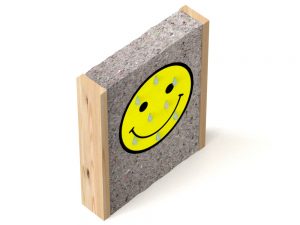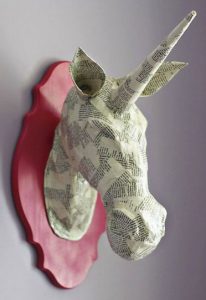Cellulose the Air Barrier
 According to some experts in our industry, cellulose insulation has truly miraculous powers. Many years ago we noticed that blower-door readings dropped significantly after we dense-packed the walls of an existing home with cellulose insulation. Before long cellulose was described as the miracle air barrier system for existing homes. People, new to our industry, surmised that cellulose was primarily an air sealant. Meanwhile Canadian researchers measured the airflow through cellulose at 50 pascals and found that cellulose’s air permeance is more than a hundred-thousand times that of an actual air-barrier material like plywood or OSB.
According to some experts in our industry, cellulose insulation has truly miraculous powers. Many years ago we noticed that blower-door readings dropped significantly after we dense-packed the walls of an existing home with cellulose insulation. Before long cellulose was described as the miracle air barrier system for existing homes. People, new to our industry, surmised that cellulose was primarily an air sealant. Meanwhile Canadian researchers measured the airflow through cellulose at 50 pascals and found that cellulose’s air permeance is more than a hundred-thousand times that of an actual air-barrier material like plywood or OSB.
I’m not pontificating against cellulose: I don’t expect it to be an air barrier. I’m a good cellulose customer. I’ve used tons and tons of the stuff and will continue to use it as appropriate. I like cellulose for attic insulation; its 13% settling doesn’t bother me at all, if you just plan for it. Too much loose-fill fiberglass in attics is just too loose to deter convection currents in cold climates.
Cellulose: Friend of Moisture
Recently experts tell me that cellulose insulation is a moisture-friendly material. Cellulose happily adsorbs water vapor and cares for the molecules until it’s time for them to fly away to rejoin their little siblings in the indoor or outdoor air after that air becomes warm and dry. Some experts say you don’t need a vapor barrier (Class I vapor retarder) in a cold-climate, new-home wall filled with cellulose. But still I wonder what happens if the little water-vapor molecules form gangs and start making trouble as condensation?
Thirty years ago in Montana, builders were building well-insulated and tight houses that were experiencing moisture problems. They weren’t installing ventilation systems and didn’t want to. The builders reasoned that eliminating the ceiling vapor barrier would rid the building of the some moisture. They were right. I witnessed area-wide consistent wetting of cellulose in two four-plex attics built like that. The top two inches of the attic cellulose were wet and frozen the day I inspected the attic at an outdoor temperature of 10 degrees F. There was also about an eighth of an inch of frost on the interior of the roof sheathing too, again throughout the entire attic. I assume that this area-wide wetting effect was caused by water-vapor diffusion. Another time I saw attic cellulose turned to paper mache. It was so hard, you could walk on it. Again the wetting effect was distributed throughout the attic floor. Without a vapor barrier, vapor diffusion happens very slowly, but it still happens. For fiberglass, rock wool, or foam, I’m not as worried.
What Simple Physics Tells Me
When I question the experts about the possibility of condensation happening in the coldest part of the moisture-friendly cellulose insulation, they tell me that Class II or III vapor retarders are all you need, according to simple physics. I think we’ve taken this vapor-diffusion-is-miniscule dogma a little too far. Simple physics and personal observations tell me that cellulose can absorb lots of water from condensation and that it never recovers from the experience. I recommend installing a vapor barrier on the warm side in cold climates when using cellulose as wall or ceiling insulation. However, don’t use a vapor barrier if the home will ever be air conditioned and so don’t insulate with cellulose in that case.

I agree w/ most of the points brought up in this article. The belief by many that cellulose is an air barrier is unfounded. The cellulose wetting problem certainly exists, seen similar stuff in NH. How much the problem results from diffusion is hard to tell, but don’t blame the air barrier,(unless the air barrier sucks) blame excess vapor in the house. Houses that run 50-65% RH in 10F conditions are going to have trouble. Occupants and homeowners should know that trouble is going to arise if bathroom exhaust and kitchen exhaust isn’t working and used effectively.
Build an awesome air barrier, and minimize vapor presence to 30 – 35% RH by exhausting it from the point source, through dedicated exhaust to outside, especially during the coldest days of the year. I think the problem is due more to excess water vapor in the house rather than the lack of an effective vapor barrier. An effective vapor barrier is likely to solve the wintertime cellulose wetting, but likely to work the wrong way in AC season. I don’t like plastic in walls due to summertime vapor drive on an air conditioned house and I don’t like plastic in ceilings because you won’t see the roof leak until everythings’ soaked up there. Just my $.02.
Years ago I read a book called “Residential Energy”. The advice there was to first control the moisture source. Having looked at lots of post-retrofit housing, my opinion is that, in the dry southwest climate where I live, if there is going to be a problem there will be evidence of that potential, pre-retrofit. If the source of the moisture can be controlled, it doesn’t matter what type of insulation is used.
But, to John’s point, cellulose or anything that is not moisture impermeable is not a good moisture barrier. I’m not sure why vapor barrier paints are not used more often to slow diffusion, rather than the use of plastic sheeting. However, I do believe, based on energy evaluation results, that cellulose or any other material packed tightly into an enclosed cavity, can act to reduce air leakage. This may be due to the fact many air leaks are not straight and direct, and the leakage sites are rarely subjected to 50pa pressure differentials.
I think I already got my $.02 cents, so this is just gratuitous.